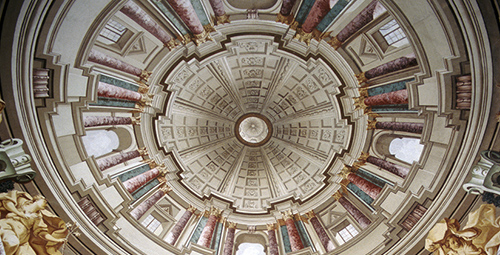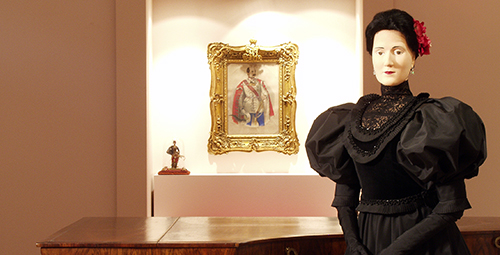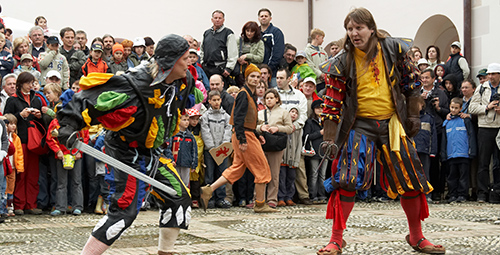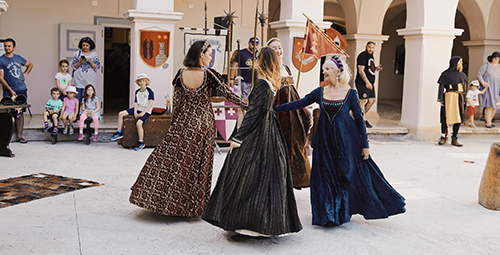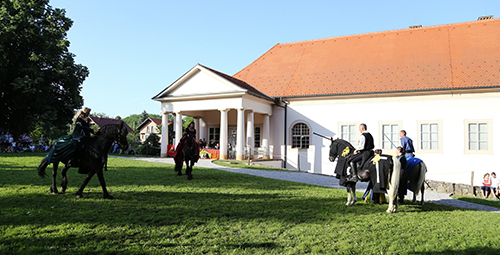Oršić Castle
The Peasants’ Revolt Museum.
History
The Baroque Oršić Palace was constructed in 1756 in Gornja Stubic on the site of an older medieval fortress by Count Krsto Oršić and his wife Josipa, neé Zichy. The palace is L-shaped and the third wing used to be connected to the older fortress from the 16th century. The new palace only served a residential purpose, as in the 18th century, there was no longer the imminent threat of invasion. The chapel, considered to be the best preserved of the whole palace, contains illusionist frescos depicting the four continents allegorically, as well as a painted altar depicting scenes from the life of Saint Francis Xavier. Both teh frescos and the altar are considered to be some of the best paintings from the Baroque period and have been attributed to the famous master painter Anton Lerhinger. Oršić Palace was a noble residence until 1924, when the last members of the Oršić family left.
Several rooms of the palace housed an elementary school for a while, and they were also used by a local peasants’ cooperative. In 1973, on the occasion of the 400th anniversary of the great Croatian-Slovene Peasants’ Revolt, a museum devoted to the revolt was installed in the palace. There is a decorative parterre garden around the castle, while the surrounding area was made into a landscaped park containing local and exotic plant species.
Monument of Matija Gubec

A monument to Matija Gubec and the Peasants’ Revolt also may be found in the park. Ambroz Matija Gubec was a Croatian peasant and the leader of the Peasants’ Revolt in Croatia and Slovenia, and so has an important place in the history of these two countires. On a hillside overlooking the Stubica valley, where the decisive battle of the Peasant Revolt took place, stands a 6.5 m high statue of Matija Gubec. With two symmetrical wings raising behind it – each 20 m long and 7.5 m high and decorated with bronze reliefs portraying over three hundred characters, the monument on one wing depicts scenes from the Battle of Stubica - people, horses and the clash of the aristocratic army and rebelious peasants, while on the other side there is a panorama depicting life at that time. At the bottom right there is a life-size figure of Petrica Kerempuh holding a tambourine.
Prior to the Peasants’ Revolt, Gubec worked as a serf on the estate of the infamous Franjo Tahy. On February 9, 1573, he led the peasants into a crucial battle against the nobility near Stubičke Toplice. Unfortunately, the peasants were defeated and Gubec was publicly tortured and executed on February 15th at St. Mark’s Square in Zagreb. According to the legend, he was crowned with a red-hot iron crown and subsequently quartered. Sculptor Antun Augustinčic was comissioned to create the monument, which was dedicated on the opening day of the Peasants’ Revolt Museum.
Exhibitions
Pernament exhibition:
- The Oršić Family and the Gallant Century
- The Castle
- Weapons and Combat Equipment in the 16th and 17th Centuries
- The Peasant Revolt - Anno Domini 1573
- Noble Estates in the 17th and 18th Centuries
- Ban Josip Jelačic and the Croatian National Revival 1848
Other exhibitions:
Sacred art in Hrvatsko zagorje
An exhibition in the baroque court chapel consecrated to St. Xavier offers an overview of the sacred art of Hrvatsko zagorje from the 16th to the middle of the 19th century. The chapel is located directly in the palace.
Viticulture and wine-cellar culture in Hrvatsko zagorje
In the cellar of the castle there is an exhibition on "Viticulture in the Hrvatsko zagorje region". It documents the history of this industry, which is extremely important for the region.
Events
In addition to the permanent exhibitions, the museum also regularly hosts concerts, theatrical performances and other events, such as the annual knight tournament in June. The Museum regularly organize workshops for children and families. Tthere is also catering directly in the castle.
Contact & Info
Oršić Castle
HR-49245 Gornja Stubica, Samci 63
Phone: +385 49 587889
or +385 49 587881
Winter: October 1. - March 31 - every day from 9 am to 5 pm.
Summer: April 1- September 30 - every day from 9 am to 7 pm.
Closed: New Year's Day, Easter, All Saints' Day, Christmas Day and December 26th.


















